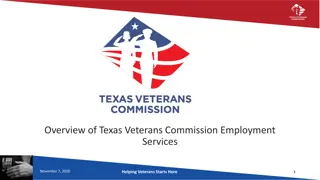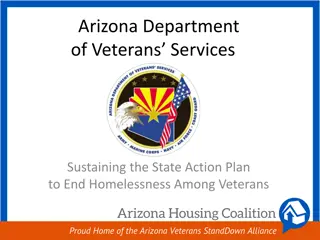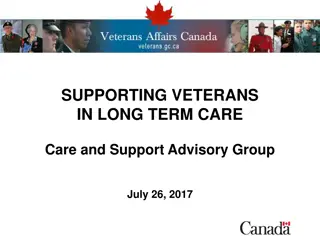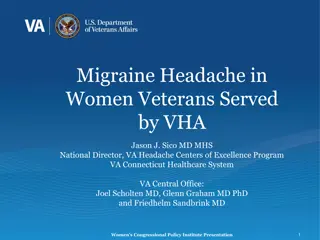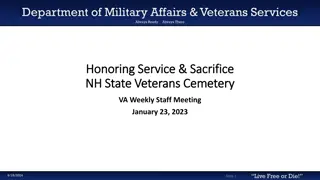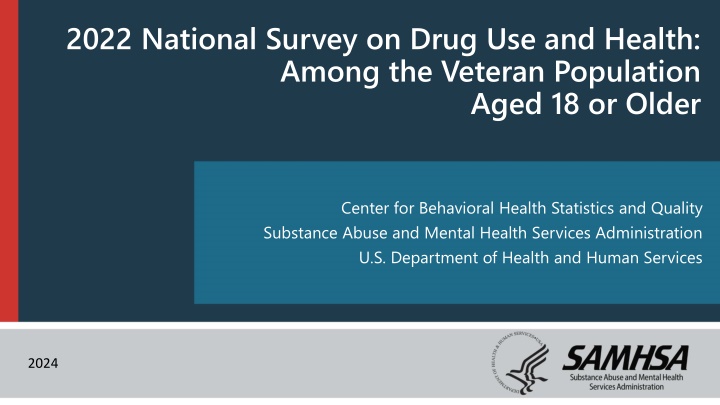
National Survey on Drug Use and Health: 2022 Veteran Population Insights
Explore insights from the 2022 National Survey on Drug Use and Health among the veteran population aged 18 or older. Learn about the scope, target population, and why data from 2022 should not be compared with prior years. Updated 2021 estimates provide a basis for comparison with the latest survey data.
Download Presentation

Please find below an Image/Link to download the presentation.
The content on the website is provided AS IS for your information and personal use only. It may not be sold, licensed, or shared on other websites without obtaining consent from the author. If you encounter any issues during the download, it is possible that the publisher has removed the file from their server.
You are allowed to download the files provided on this website for personal or commercial use, subject to the condition that they are used lawfully. All files are the property of their respective owners.
The content on the website is provided AS IS for your information and personal use only. It may not be sold, licensed, or shared on other websites without obtaining consent from the author.
E N D
Presentation Transcript
2022 National Survey on Drug Use and Health: Among the Veteran Population Aged 18 or Older Center for Behavioral Health Statistics and Quality Substance Abuse and Mental Health Services Administration U.S. Department of Health and Human Services 2024 1
NSDUH Scope and Target Population Conducted by the Federal Government since 1971 Comprehensive household interview survey of substance use, substance use disorders, mental health, and the receipt of treatment services for these disorders in the United States Produces estimates representative of the population at national and state levels Covers the civilian, noninstitutionalized population aged 12 or older in all 50 states and Washington, DC: Includes households, college dorms, homeless in shelters, civilians on military bases Excludes active military, long-term hospital residents, prison populations, homeless not in shelters NSDUH 2022 sample included 71,369 people (including 2,880 Veterans) 2
Data from 2022 should not be compared or pooled with data from 2020 or prior years Why not? 1 Mode effect: Web data collection began in 2020. There were significant differences in estimates between web and in-person modes of data collection. Seasonal effect: There were systematic differences between two-quarter estimates from 2015 to 2019 and corresponding four-quarter estimates. Because 2020 data were mostly collected in only two quarters, these data cannot be compared with the full year of 2022 data. 2 Substance Use Disorder (SUD) definition changes: Starting in 2020, SUDs were defined according to criteria from the Diagnostic and Statistical Manual of Mental Disorders, 5th edition (DSM-5). Therefore, SUD estimates cannot be compared with 2019 or earlier. 3 3
Updated 2021 Estimates Prior analyses showed differences in estimates between web and in-person modes of data collection. Because the proportion of interviews completed via the web or in-person was not stable between 2021 and 2022, differences in estimates could be due to mode effects rather than real changes in the population. In 2022, weighting procedures were updated to stabilize the effect of mode on estimates across years.1 These procedures also were applied to the 2021 analysis weights. Updated 2021 estimates were generated for the 2022 Detailed Tables to facilitate comparisons with 2022 estimates. These updated 2021 estimates should be used for comparison with 2022 estimates. 1 See Section 3.3.3 in the following reference: Center for Behavioral Health Statistics and Quality. (2023). 2022 National Survey on Drug Use and Health (NSDUH): Methodological Summary and Definitions. https://www.samhsa.gov/data/report/2022-methodological-summary-and-definitions. 4
About This Presentation Statistical testing was performed for comparisons of estimates across age groups and across veteran status according to procedures described in the 2022 Methodological Summary and Definitions report.1 Differences were considered statistically significant at the .05 level of significance. Statistically significant differences resulting from these testing procedures are described using terms such as higher, lower, more likely, or less likely. Statements use terms such as similar or the same when a difference was not statistically significant. When estimates are presented without reference to differences across groups, statistical significance is not implied. 1 See Section 3.2.3 in the following reference: Center for Behavioral Health Statistics and Quality. (2023). 2022 National Survey on Drug Use and Health (NSDUH): Methodological Summary and Definitions. https://www.samhsa.gov/data/report/2022-methodological-summary-and-definitions. 5
Past Month Substance Use: Among Veterans Aged 18 or Older Rx = prescription. Note: The estimated numbers of current users of different substances are not mutually exclusive because people could have used more than one type of substance in the past month. 7
Past Month Alcohol Use, Binge Alcohol Use, and Heavy Alcohol Use: Among Veterans Aged 18 or Older More than a third of past month alcohol users were binge drinkers Note: Binge Alcohol Use is defined as drinking five or more drinks (for males) or four or more drinks (for females) on the same occasion on at least 1 day in the past 30 days. Heavy Alcohol Use is defined as binge drinking on the same occasion on 5 or more days in the past 30 days; all heavy alcohol users are also binge alcohol users. 8
Binge Alcohol Use in the Past Month by Veteran Status: Among Adults Aged 18 or Older No significant differences in prevalence of binge alcohol use between Veterans and Non-Veterans Note: Binge Alcohol Use is defined as drinking five or more drinks (for males) or four or more drinks (for females) on the same occasion on at least 1 day in the past 30 days. 9
Type of Tobacco Product Use and Nicotine Vaping: Among Veterans Aged 18 or Older Who Used Nicotine Products in the Past Month Nearly 80% of Veterans who used nicotine products in the past month used only tobacco products Note: The percentages may not add to 100 percent due to rounding. 10
Past Month Nicotine Vaping: Among Veterans Aged 18 or Older The percentage of people who vaped nicotine was highest among Veterans aged 18 to 49 11
Past Year Illicit Drug Use: Among Veterans Aged 18 or Older Rx = prescription. Note: The estimated numbers of past year users of different illicit drugs are not mutually exclusive because people could have used more than one type of illicit drug in the past year. 13
Past Year Illicit Drug Use and Marijuana Use: Among Veterans Aged 18 or Older Among Veterans aged 18 to 49, 32.7% used illicit drugs and 30.5% used marijuana in the past year 14
Illicit Drug Use in the Past Month by Veteran Status: Among Adults Aged 18 or Older No significant differences in prevalence of illicit drug use between Veterans and Non- Veterans 15
Marijuana Use in the Past Month by Veteran Status: Among Adults Aged 18 or Older No significant differences in prevalence of marijuana use between Veterans and Non- Veterans 16
Type of Marijuana Use: Among Veterans Aged 18 or Older Who Used Marijuana in the Past Month 1 in 4 current marijuana users aged 18 or older vaped marijuana in the past month * Low precision; no estimate reported. 17
Opioid Misuse in the Past Month by Veteran Status: Among Adults Aged 18 or Older No significant differences in prevalence of opioid misuse between Veterans and Non- Veterans 19
Past Year Prescription Pain Reliever Misuse: Among Veterans Aged 18 or Older Who Used the Specific Prescription Pain Reliever Subtype in the Past Year * Low precision; no estimate reported. 20
Past Year Substance Use Disorder (SUD): Among Veterans Aged 18 or Older Note: The estimated numbers of people with substance use disorders are not mutually exclusive because people could have use disorders for more than one substance. 1 Includes data from all past year users of marijuana, cocaine, heroin, hallucinogens, inhalants, methamphetamine, and prescription psychotherapeutic drugs (i.e., pain relievers, tranquilizers, stimulants, or sedatives). 2 Includes data from all past year users of the specific prescription drug. 22
Past Year Substance Use Disorder: Among Veterans Aged 18 or Older Veterans aged 18 to 49 were more likely to have a past year substance use disorder, alcohol use disorder, or drug use disorder than Veterans aged 50 or older 1 Includes data from all past year users of marijuana, cocaine, heroin, hallucinogens, inhalants, methamphetamine, and prescription psychotherapeutic drugs (i.e., pain relievers, tranquilizers, stimulants, or sedatives). 23
Substance Use Disorder in the Past Year by Veteran Status: Among Adults Aged 18 or Older No significant differences in prevalence of substance use disorder between Veterans and Non-Veterans 24
Perceived Need for Substance Use Treatment: Among Veterans Aged 18 or Older with a Past Year Substance Use Disorder Who Did Not Receive Substance Use Treatment in the Past Year Nearly all Veterans with a substance use disorder who did not receive substance use treatment did not think they needed treatment Note: Respondents with unknown perceptions of need for substance use treatment were excluded from the analyses. 25
Any or Serious Mental Illness: Among Adults Aged 18 or Older 26
Past Year Mental Illness: Among Veterans Aged 18 or Older The prevalence of mental illness was higher among Veterans aged 18 to 49, for both any mental illness and serious mental illness, than among Veterans aged 50 or older 27
Any Mental Illness in the Past Year by Veteran Status: Among Adults Aged 18 or Older Veterans were less likely to have a mental illness than Non-Veterans 28
Receipt of Mental Health Treatment in the Past Year: Among Veterans Aged 18 or Older with Mental Illness in the Past Year Approximately half of Veterans with AMI received mental health treatment in the past year AMI = any mental illness. Mental health treatment includes treatment/counseling received as an inpatient or as an outpatient; use of prescription medication to help with mental health; telehealth treatment; or treatment received in a prison, jail, or juvenile detention center. 29
Receipt of Mental Health Treatment by Veteran Status: Among Adults Aged 18 or Older with a Past Year Mental Illness No significant differences in prevalence of the receipt of mental health treatment between Veterans and Non- Veterans who have a mental illness 30
Serious Thoughts of Suicide, Suicide Plans, and Suicide Attempts 31
Past Year Serious Thoughts of Suicide, Suicide Plans, or Suicide Attempts: Among Veterans Aged 18 or Older Thoughts of suicide were higher among Veterans aged 18 to 49 than among Veterans aged 50 or older 32
Serious Thoughts of Suicide in the Past Year by Veteran Status: Among Adults Aged 18 or Older No significant differences in prevalence of serious thoughts of suicide between Veterans and Non-Veterans 33
Made a Suicide Plan in the Past Year by Veteran Status: Among Adults Aged 18 or Older No significant differences in prevalence of making a suicide plan between Veterans and Non-Veterans 34
Attempted Suicide in the Past Year by Veteran Status: Among Adults Aged 18 or Older Veterans were less likely to have attempted suicide than Non-Veterans 35
Co-Occurring Substance Use Disorder and Mental Illness: Among Adults Aged 18 or Older 36
Co-Occurring Substance Use Disorder and Any Mental Illness: Among Veterans Aged 18 or Older 1.4 million (7.2%) Veterans aged 18 or older had co-occurring SUD and AMI Nearly half (49.4%) of all Veterans aged 18 to 25 had SUD or AMI AMI = any mental illness; SMI = serious mental illness; SUD = substance use disorder. 37
Past Year Substance Use by Mental Illness: Among Veterans Aged 18 or Older Veterans with AMI in the past year were more likely to have used or misused these substances (except binge alcohol use) than those without mental illness * Low precision; no estimate reported. AMI = any mental illness. + Difference between this estimate and the estimate for adults aged 18 or older without mental illness is statistically significant at the .05 level. 38
Did Not Receive Substance Use Treatment or Mental Health Treatment in the Past Year: Among Veterans Aged 18 or Older * Low precision; no estimate reported. 39
Recovery: Among Veterans Aged 18 or Older 4 in 5 (80.2%) Veterans who ever had a substance use problem considered themselves to be recovering or in recovery 2 in 3 (64.7%) Veterans who ever had a mental health issue considered themselves to be recovering or in recovery 40










